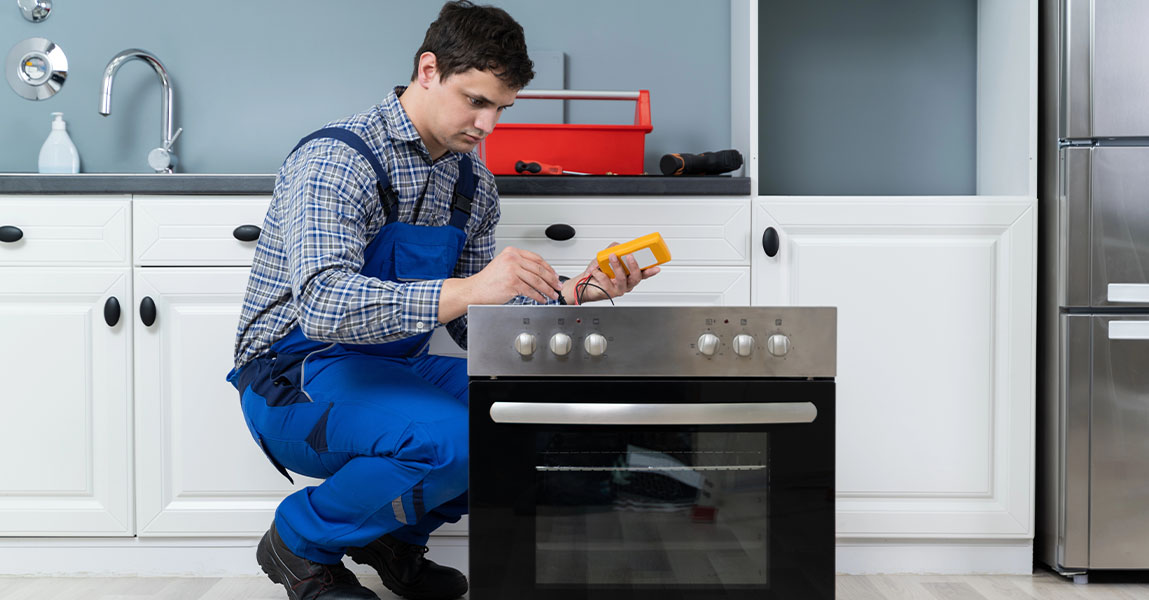When your oven door won’t close all the way, the first thing to consider is whether something is physically blocking it. For example, a misaligned oven rack or a fallen crumb guard might be the culprit. Therefore, we always advise starting with a thorough inspection of the oven’s interior.
In addition, you should gently test the movement of the door by opening and closing it slowly. If it catches midway or feels unusually loose, the issue might not be internal obstruction but mechanical failure. Likewise, problems like warped hinges or broken springs can easily disrupt how the door seals.
We often find that over time, hinges can shift from repeated use. Consequently, a door that once closed snugly may begin to sag or tilt. This uneven closure compromises the oven’s ability to retain heat and cook evenly.
Assessing the Door Hinges and Springs
Door hinges take a great deal of stress during the life of an oven. That is to say, every time you open and shut the oven, the hinges are absorbing impact and tension. Over time, wear and tear will take their toll. Similarly, the springs that assist in tensioning the door can weaken or snap entirely.
If your door hangs slightly open or swings too freely, hinge or spring failure is likely the cause. To clarify, you’ll want to remove the oven door carefully and check for visible rust, damage, or bent components. However, not all oven models make this process simple.
In many cases, homeowners contact our team after trying to adjust or replace hinges themselves and finding it more difficult than expected. In those situations, we recommend seeking professional oven repair in Burbank to ensure the work is done safely and correctly.
Checking the Gasket for Deformation or Gaps
Another common reason your oven door won’t shut tight is a worn-out gasket. This rubber seal goes around the door frame and is responsible for keeping heat in during operation. However, the gasket can harden or tear over time, especially with regular exposure to heat and moisture.
We’ve seen many cases where the door technically “closes” but the seal remains incomplete. Consequently, heat escapes and causes food to cook unevenly or requires longer cooking times. You should run your fingers gently along the gasket to feel for any gaps or hardened spots.
If the gasket appears brittle, cracked, or loose, it will need to be replaced. For situations like these, we usually recommend scheduling an appointment through a contact page like this one: schedule appliance repair service in Burbank. That way, your oven is fixed before any further damage occurs.
Inspecting the Door Latch and Locking Mechanism
Some ovens include a locking latch, especially for self-cleaning models. If the latch becomes jammed or misaligned, the door may not close properly even when pushed firmly. That is to say, the latch may partially extend or become stuck due to grime, heat warping, or a defective sensor.
In this case, gently inspect the latch area while the oven is off and cool. Do not force it back into place. Instead, test whether the latch moves freely or appears bent. Sometimes cleaning the latch track with a soft cloth and warm water will restore function.
However, if the latch is tied into an electrical lock mechanism, it may require expert repair. We recently handled a case where this exact issue caused the client to believe their door hinge was broken, when in fact it was a stuck latch motor. For these more complex cases, you may want to start by reviewing general appliance repair services in Burbank to ensure you’re informed before taking further action.
When the Oven Frame or Door Warps from Heat
Oven door misalignment may also result from warping, particularly in older models or those that have undergone multiple self-cleaning cycles. Excessive heat can cause metal components to expand unevenly and lose shape. As a result, the door won’t align with the frame, leaving a noticeable gap when closed.
This problem is harder to diagnose at a glance. That is to say, the door may appear straight but won’t fit flush against the frame. A quick way to check is by placing a thin strip of paper along the door edge and closing it. If the paper pulls out easily, the seal isn’t tight.
Unfortunately, warped components often cannot be reshaped without compromising the oven’s structure. In those cases, repairs or part replacements are necessary. To find assistance for such work, you can reference reliable oven service in Burbank where service teams are familiar with this specific issue.
Frequently Asked Questions
Why does my oven door pop open slightly after I close it?
This usually means the hinges or springs are worn out. As the components lose tension, the door can’t stay flush and will reopen slightly after being shut.
Can I use my oven if the door doesn’t close all the way?
No, using your oven in this condition is unsafe. It will not maintain the correct temperature, may leak heat into your kitchen, and can cause damage to the surrounding cabinetry.
Is it easy to replace an oven door hinge by myself?
Some models allow for relatively easy hinge replacement, but many require partial disassembly or special tools. If you’re unsure, it’s safer to let a technician handle the repair.
What if the oven door looks fine but it still doesn’t seal?
Even when the door seems fine visually, a worn or damaged gasket could be the problem. Check for missing sections or hardened rubber that doesn’t compress properly.
How do I know if the door latch is the issue and not the hinges?
If the door moves smoothly but won’t stay shut, or if it doesn’t lock during a self-cleaning cycle, the latch could be faulty or stuck. Hinges usually cause sagging or difficulty in movement.

